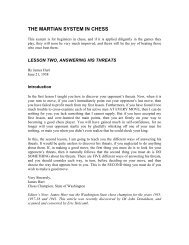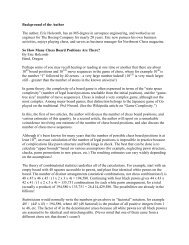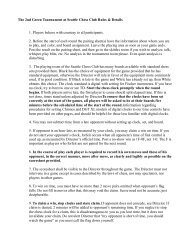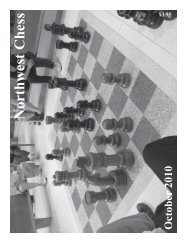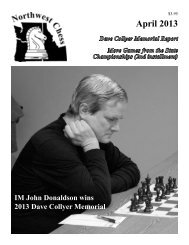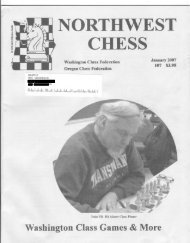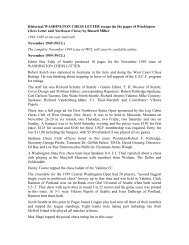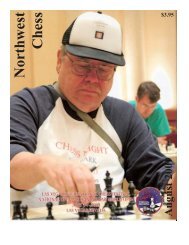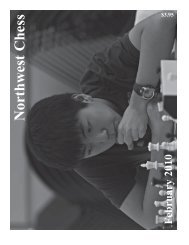201211 - Northwest Chess!
201211 - Northwest Chess!
201211 - Northwest Chess!
You also want an ePaper? Increase the reach of your titles
YUMPU automatically turns print PDFs into web optimized ePapers that Google loves.
27.Rd2 Bf3+ 28.Kh2 Re8.<br />
15...Bxc3<br />
15...Nc6 16.Nd5 Qd6 17.Bf4 Bxf4<br />
18.Nxf4 Bg4 19.Qg3 Ne5 20.Nd3<br />
Qh6+ 21.Kg1 Nxd3 22.cxd3 Qb6+<br />
23.Kh1 Be6 24.Bxe6 Qxe6 with<br />
some advantage.<br />
Kxf7 25.Qd5+ Kg6 26.Qe6+ Kh5<br />
27.Qh3+ Kg6 28.Qe6+ Kh5=.<br />
21.e5 Bxb3 22.Qxb3 Nd8 23.Rf3<br />
Qe6 24.c4 b6<br />
16.Qxc3 Nc6 17.Bf4 Be6 18.Qg3<br />
18…Qf6!<br />
Unexpected I think. Though I<br />
missed Bxb3 line with a small advantage,<br />
this is still good. 18...Bxb3<br />
19.Bd6 (19.Bh6? Qe5–+) 19...Qe6<br />
20.Bxf8 (20.axb3 Rfe8 21.Rae1 Qg6<br />
22.Qxg6 hxg6 23.e5) 20...Qh6+<br />
21.Kg1 Bc4 22.Bc5 Bxf1 23.Rxf1<br />
Qe6.<br />
19.Bd6<br />
19.Bd5 Rfe8 20.c3 Rad8 21.Rad1<br />
Rd7 22.Be3 Qe7 23.Bg5 Qf8=<br />
19...Qh6+ 20.Kg1 Rfe8<br />
20...Bxb3 21.axb3 (21.Bxf8 Bc4)<br />
21...Rfe8; 20...Nd4 21.Qd3 Bxb3<br />
22.Qxd4 (22.Bxf8 Qb6 23.Bxg7 Kxg7<br />
24.Kh1 Bxc2 25.Qg3+ Kf8 26.Rxf7+<br />
Kxf7 27.Rf1+ Ke6 28.Qg4+ Kd6<br />
29.Rf6+ Kc5 30.Qh5+ Kc4 31.Qf7+<br />
Kd3 32.Rxb6 axb6 33.e5 Ke3 34.e6 Bg6<br />
35.Qxb7 Ra5 36.Qxb6 Rh5+ 37.Kg1<br />
Re5=) 22...Rfd8 23.e5 Bxc2 24.Rxf7<br />
My knight should become much<br />
better, with the f6 idea, and Nf7. If<br />
24...Nc6, I calculated that this line<br />
ends in a draw 25.Qxb7 Na5 26.Qc7<br />
Nxc4 27.Raf1! Nxe5! (27...Nd2?<br />
28.Rxf7+-) 28.Bxe5 Re7 29.Qd6<br />
Qxe5 30.Qxe5 Rxe5 31.Rxf7=.<br />
25.Qc3 Rc8 26.b3 f6 27.Re1 Nf7<br />
28.Rfe3 Qd7 29.Rd3<br />
29.e6 Qxd6 30.exf7+ Kxf7 31.Rxe8<br />
Rxe8 32.Rxe8 Kxe8 33.Qf3 he could<br />
hopefully draw; 29.Qd4 computer<br />
line 29...Qc6 30.c5! bxc5 31.Qc4<br />
a6 32.Rg3 Qb7 33.Rf1 (33.Rd1 fxe5<br />
34.Rf1 Rcd8 35.Bxc5 Qd5 36.Qc2 e4)<br />
33...Qb4 34.Rxf6 Qxc4 35.bxc4 a5<br />
36.Kh2 a4 37.a3 Rc6 38.Rf5 Nxd6<br />
39.exd6 Rd8 40.Re3 h6 41.Re7<br />
Rdxd6 42.Ra7 Rd2 43.Kg1 Rg6<br />
44.Rf2 Rd1+ 45.Rf1 Rd4 46.Rxa4<br />
Kh7 47.Rf2 Rd1+ 48.Kh2 Rc1<br />
49.Ra8 Rxc4 50.a4 Rb4.<br />
29...Qe6 30.Rde3 Red8 31.Qb4 f5<br />
32.Rd3 h6 33.a4<br />
[Diagram Next Column]<br />
33…Rc5?!<br />
Kind of a weird move played as a<br />
result of his time pressure.<br />
34.Qc3 Rc6 35.Ba3 Re8 36.Bb2<br />
Ng5 37.a5 b5 38.c5 Ne4 39.Rxe4!<br />
Very strong and precise sacrifice.<br />
39…fxe4 40.Rd6!<br />
Good find by Carl, and now I use<br />
up all my time before move 40, calculating<br />
Rxd6 (seems to lose), and<br />
what happens after Qc8 e6.<br />
40...Qc8 41.e6 Rc7 42.Qe5<br />
42.Qd4, as pointed out in analysis is<br />
<strong>Northwest</strong> <strong>Chess</strong> November 2012 Page 25



